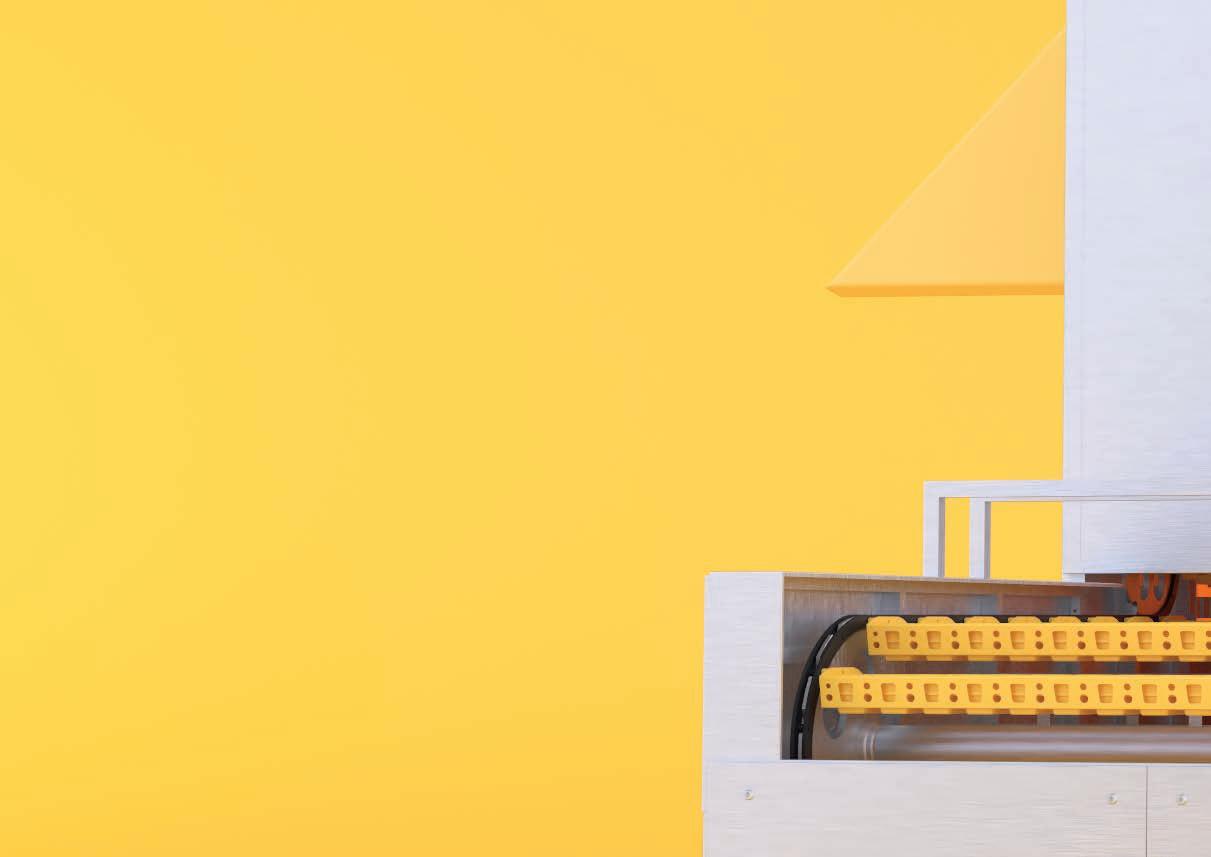
7 minute read
A compact helper for medium-sized bakeries
from Magazín !dea 02 [EN]
by kornfeil

Thanks to its compactness and quick installation of ThermoStar Classic, it is one of the most popular products from Kornfeil's multi-deck ovens. But what about the practical experience of customers? Gudbjartur Gudbjartsson from Artic Bakehouse will talk about the issue and present their oven.
Advertisement
Which bakery products do you mainly use the ThermoStar classic oven for?
We mainly use it for sourdough bread, which is one of our main products, and this oven is perfect for this type of bakery product range.
The hallmark of any good bread is a perfect crust, is the ThermoStar classic equal to steam ovens in this respect?
Before we switched to ThermoStar classics, we used steam ovens. We have to say that the ThermoStar is far superior in this respect. The biggest difference compared to steam ovens is that the quality of the bread is much more constant. We have had better days and worse days when baking in steam ovens. With ThermoStar classic, the quality is the same every day.
ThermoStar classic is a very compact and easy to install device thanks to its integrated boiler. Did this factor play any part in you choosing a new oven for your bakery?
Yes, the ease and speed of installation played a big part in our decision and choice of a new oven. The oven is also very compact and fit perfectly into our bakery space.
Approximately how long did it take to assemble this oven?
The whole installation took between four and five days. We believe that for many bakers this is also a big deciding factor as they don't have to stop their operation for long. Fortunately, we didn't have to solve this problem because we placed the new oven in a brand-new space, but we are still very happy that the installation was not complicated. Plus, the oven will arrive to you as a single unit, which adds greatly to the ease of installation.
Is there any range that this oven doesn't suit?
Of course, some bakery products are better baked in other types of ovens. But for us this oven is ideal, we bake sourdough bread in it, for which it is perfect, but for sweet pastries, for example, we prefer to use a different type of oven. But we can still say that the ThermoStar classic is the flagship of our bakery.
Have you noticed a reduction in operating costs after switching to the ThermoStar classic?
In this case it is quite difficult to answer because we have placed the oven in a different location where the energy prices are completely different. Another reason why it is difficult to answer this question is that we have increased our production significantly and have grown quite a bit by switching to this oven. But we are 100% sure that without this oven our costs would have been much higher. Perhaps in hindsight we will have more accurate figures in this respect but given that we have had this oven for a relatively short period of time, we are unable to say exactly how much this oven has saved us.
Have you thought about investing in an Ekoblok to reduce your costs even further?
We are definitely thinking about it, we talked about it right after the oven was installed. We also want to invest in this technology in the future.
Which bakeries would you recommend this oven to?
Basically, we would recommend it to bakeries like ours, so medium-sized bakeries that bake up to a thousand loaves a day. Smaller bakeries would not make the most of the oven's potential.
A wide range of products even at high outputs. Continuous Kornfeil proofers.
The common denominator of industrial bakeries has always been a narrow product range with high baking outputs, which allow economies of scale but at the same time significantly reduce the attractiveness of the bakery portfolio. It is the alpha and omega of successful product placement in multinational chains, as well as a measure of sales to end customers. With the use of Kornfeil continuous proofers, this success can also be achieved in industrial bakeries.
All Kornfeil continuous proofers are manufactured by the Kornfeil Industry subsidiary. The individual models are thus primarily developed and built to match Kornfeil deck oven assemblies or Kornfeil thermo-oil conveyor ovens. Our proofers are always custom designed to the specific specification of the required output and the breadth of the product range. We offer control of all components of the line, both the ovens and the baking plant, by one control software MultiControl, which can be gradually equipped with additional devices according to the growth and development of the bakery product portfolio.
Several types of proofers have been developed and built based on client requirements. This technology is developed with an emphasis on the variability of proofing time and temperature. In recent years, for qualitative reasons, there has been a shift away from high temperatures and short rising times to lower temperatures of around 26–28°C and variable rising times of between 90–120 minutes. This means a completely different technical solution in terms of the movement of the hinges or plates and the possibility of humidifying and circulating the internal air. In general, most continuous proofers are heated from the waste heat of the proofer by the Ekoblok. However, ensuring sufficient humidification of the proofer space at lower temperatures offers more options, namely humidification with a fine mist produced by an ultrasonic aggregate. The adiabatic process thus cools the proofer and represents the most cost-effective method of humidification. A similar effect can be achieved by humidification in the form of spraying pressurized water with air, which is also widely used. The most energy-intensive method is low-pressure steam from the central boiler room, which consumes 700W/1 kg of steam and is mainly used at proofing temperatures above 30°C.
And now to the individual models of automatic continuous proofers. These meet the requirements for the production of classic bread in oval or round shape, loose-leavened products or ciabatta-type products that require rolling, breadsticks and similar products that rise on a baking sheet, and standard proofers for the production of Czech rolls and buns.
Continuous bread proofers
Bread proofers are among the most frequently installed proofers in the Czech Republic and Slovakia, together with lines based on deck ovens, which is due to the primary orientation of Czechoslovak bakeries towards classic consumer bread. Proofers are just as frequently installed together with conveyor ovens. The most comfortable model is hanging bread proofers with baskets, which have been developed for the assemblies of deck ovens with very variable use and are available with one or two types of baskets, oval or round.
The classic continuous bread proofer DUO is equipped with two types of rattan baskets, round for bread weights of 300–800g or oval for bread weights of 300g–1200g. The breads are transferred to the line through two loading devices for both oval and round breads.
The dough tipping is fully program-controlled, so that the dough wedges fall perpendicularly and without deformation onto the feed table. We can also adjust the angle of the hinge and the speed of rotation, which fully simulates the manual work of a skilled baker. A properly configured proofer allows us to produce a wide range of breads from pure wheat to breads that have 80% rye. The feed table, on which the wedges are tipped, has a pneumatic lifting system that ensures tipping from the lowest possible height. The proofer can thus be used for proofing very loose doughs.
Like our entire product range, the continuous proofer is controlled by MultiControl software. This connects the individual elements of the line, in layman's terms, everything speaks the same language. The proofer operates fully automatically according to the desired settings and is controlled by a main control panel where the operator can easily check which hinges are filled with dough, thanks to the identification of integrated chips in each of the hanging baskets.
The assortment can be easily rotated, but with good planning of dough preparation and a minimum assortment quantity of 100–500 pieces. For optimum temperature and humidity distribution, air is circulated in the proofer by means of an air handling unit including cooling. Customers appreciate this especially during the summer months, when the rising temperature of conventional bread ovens ranges from 30 to 35°C in 45–55 minutes.
Slab and plate proofers
The assortment can be easily rotated, but with good planning of dough preparation and a minimum assortment quantity of 100–500 pieces.
Even rustic products can be easily produced with the help of molding lines, and the wedges are then automatically loaded on the plates and proofed at cooler temperatures, thus ensuring the suppleness and high quality of the product. We supply proofers mainly to Poland, Romania, Hungary, generally for the free-fermenting wheat markets. However, we see a huge potential for offering free-fermented products in our country as well. A wide range of wheat bakery products does not mean complicated production.
For the above products, fixed slab and plate with ciabatta dough rolling can be used.
Continuous proofer with plates
The above-mentioned proofers offer two alternatives: with a fixed proofing time, where the plates with the bakery product move horizontally or vertically on a chain track. This is a relatively simpler type of proofer, similar to a hanging proofer.
The second variant, with a variable rising time of e.g., 60–120 minutes, is technically more complex and more costly. The proofing plates move only vertically in separate towers and by omitting the designated towers the proofing time is varied according to technological requirements. The same principle is used by proofers on baking sheets, but instead of plates, the towers are fitted with sheets. This is how the typical French baguettes or salted beer breadsticks are produced.
Continuous proofers for molded bread
The growing popularity of molded breads encouraged the development of a continuous proofer for just such bread, which is a very interesting export item in foreign industrial bakeries. These are hanger-type proofers with the possibility of variable rising times, where whole cassettes of molds are moved at the proofer inlet to individual hinges. After proofing, they are ejected at the outlet for further sprinkling or slicing, and then primarily conveyor ovens are used for baking. The automatic line for the production of wheat, rye or whole meal mold bread is always equipped with fully automatic technology for the collection of finished bread, returning, cleaning and cooling of molds and other additional equipment according to the final product.
All continuous proofers can be equipped with accessories for sprinkling, slicing and moistening, thus significantly expanding the possibility of assortment production using one type of dough.
For cutting products for high-performance lines, we cooperate with foreign partner companies that offer robotic cutting with rotating discs or the so-called plotter system from the Spanish company Auxpama.
Our experience with the production and installation of continuous proofers to date has convinced us of the significant benefits of continuous proofers in medium and industrial bakeries with a minimum daily production capacity of 5,000 pieces of bread/day. They consistently confirm significant savings on wage costs due to the saving of 3–4 production workers depending on the production volume, easier expansion of the product portfolio with an average economic return of 4–5 years without the use of European subsidies.

















